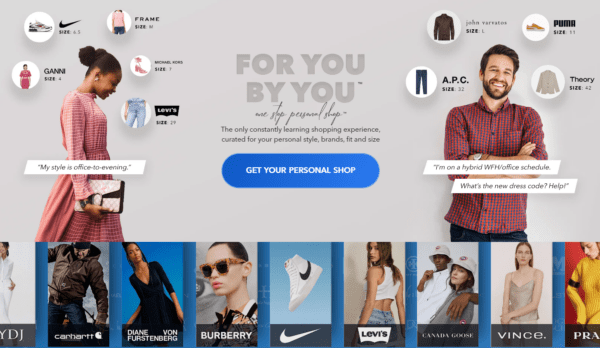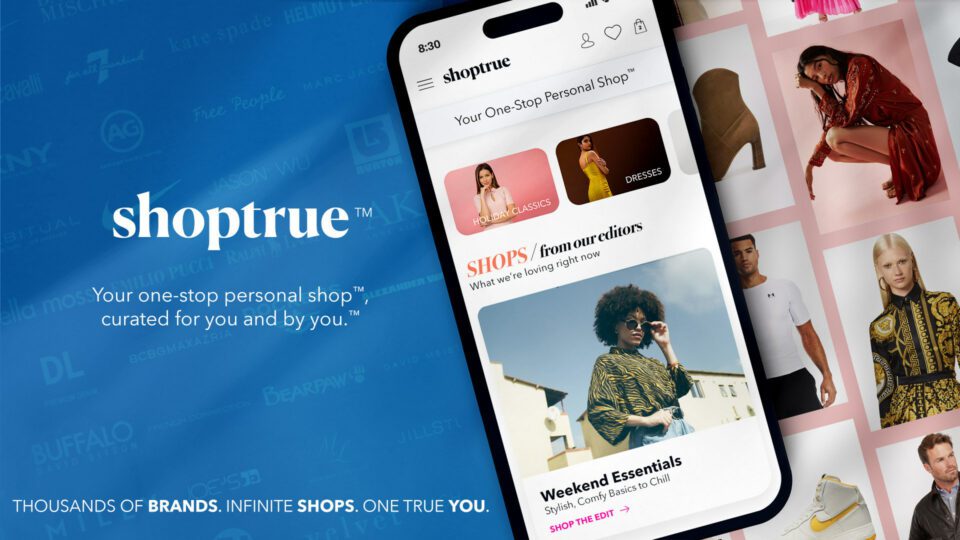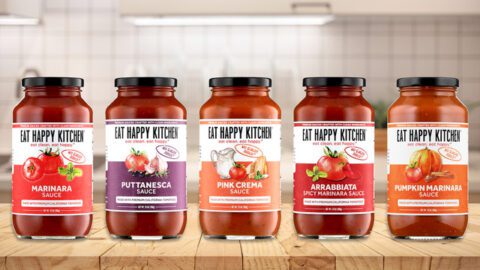These days it seems that facilitating discovery is the holy grail of ecommerce. Countless companies both big and small — including Meta, Pinterest and Google — are trying to tackle the challenge of making shopping online more like shopping IRL, where inspiration can strike at any moment and from any direction.

One of the newest entrants in the space is Shoptrue, which launched in open beta in November 2022. Described as a “constantly learning fashion marketplace,” the platform combines AI and human curation to present each shopper with a personalized selection of fashions from more than 2,000 participating brands. Shoppers can also create, and share, “fashion playlists” to gather inspiration and spur discovery among other users, much like they can on platforms like Pinterest or Spotify.

Shoptrue is notable not just because of its fresh take on digital-social shopping but also because of the names behind it. The platform is founded and led by Romney Evans, who also co-founded the successful fit technology solution True Fit, which is now used by close to 20,000 brands. Alongside him are Chief Fashion Officer Brandon Holley, who had a long career in publishing that included stints as the Editor-in-Chief of titles including Lucky and Jane, as well as VP of Data Science John Lashlee, who hails from some of the top names in tech, including Netflix and LinkedIn.
“Romney and I started talking years ago, because we both felt the same thing, which was that ecommerce needs to move a little bit, it needs to get a little bit better,” said Holley in explaining her mid-career shift from publishing to tech. “I often say that ecommerce has a listening problem. It’s very much built on this one-way model and [Romney and I] really like this idea of more push and pull.”

That push and pull is evident in the platform they are building. Notably it’s not a direct-sales website or a marketplace but rather an ecommerce conduit, with all orders going through to the brands themselves. “We have unified checkout, which allows users to add items from multiple merchants to the same cart, but those orders are placed with the various merchants, and then the merchants fulfill them directly,” explained Evans.
Evans and Holley sat down with Retail TouchPoints to share more about their vision for fashion discovery in the age of ecommerce and how they are working to bring it to life.
Retail TouchPoints: So what are you trying to do differently with Shoptrue?
Romney Evans: I think the thing that’s different about our approach when it comes to fashion discovery is this idea of “for you, by you,” which informs everything that we do. We’re really trying to harmonize two ideas. One is AI-driven recommendations. A lot of companies attempt to do this well, but it’s a top-down approach, making the best guesses at what consumers will like based on the available data. But I think what’s been missing is the other side of the equation, the “by you.”
There’s been a lot of chatter on Instagram and other platforms, because people are frustrated that they have very little control over what shows up in their feed. And similarly, I think fashion has largely been the same — there’s an authority source, whether that’s an algorithm or a human — that sort of talks down to the audience. It gives them a style point of view that tells them how they should dress. What we’re trying to do is not totally get rid of that but to actually harmonize it with the idea of putting the shopper in the driver’s seat and giving them the control to participate actively in the curation process for themselves.
So the idea is to create a one-stop personal shop for every user where their shop gets curated for them across thousands of brands in one place, based on their style, brands they like, fit, size, etc. But then we give them the tools to collect, organize and share their fashion point of view [POV] through “fashion playlists.” And these fashion playlists become very similar to what you do on Pinterest — this is my fashion playlist for work; this is my fashion playlist for working out; this is my fashion playlist for date nights; this is my fashion playlist of ideas for mom for Christmas.
We’re not trying to deny the AI part. We’re actually trying to harness that to make it easier in every part of the shopper journey to find something that you’re likely going to love. But we’re also kind of embracing the fact that AI is limited. AI has always fallen on its face when people expect it to [do something like] know their style better than they do. We’re saying that the user understands their style better than anyone else, so we’re going to put them in the driver’s seat.
RTP: You’re reminding me of something a user of another shopping service told me, which is essentially that the machine only knows what choices you’ve already made, but it’s very hard to get a machine to tell you what you want next.
Brandon Holley: Yeah, that exact thing happened to me on another platform actually. I indicated a brand that I was into at the moment, Altuzarra. [My enthusiasm] eventually trailed off, but three years later, I’m still getting recommendations for Altuzarra. I think that’s where Shoptrue is different. Your style quiz, that initial intake, is your zero position, but everything you do after that keeps evolving it. There’s no snapshot of you that’s frozen in time.
RTP: And especially in fashion, you’re always looking for newness, but that’s hard for a machine to pull out of thin air.
Holley: Exactly. That’s why we’re bringing the AI in with human expertise and blending the two. If you think about content, it goes from expert to local experts to more like UGC [user-generated content]. But really when it comes to fashion, we are all experts. On Shoptrue everyone can have a POV with their fashion playlists and send it to their friends. My team will do the top of the pyramid, creating the big stories, but you might say, “Hey, we’re going to Mexico for our friend’s wedding. Here’s a playlist where we all can shop for that.”
RTP: So where do things stand today with the platform today?
Evans: We’re off to the races. We’ve launched our beta and we’re still laying the pipes and getting the foundation set before we start accelerating and trying to grow the user base. We’re doing a lot of user testing and rolling out new features, like our “favorites” capability, which sounds kind of basic, but I think we have a unique take on it because it’s tied to stuff that’s active in inventory.
We’re also working actively on personalized size curation. In our user testing, we found that a huge problem was stockouts. Especially in December during the holidays, there are lots of items that you like but aren’t available in your size. This new capability that we’re building allows us to filter out for a given user any items that are not available in their recommended size, which we think will take a lot of friction out of the purchase process, especially when we have such a big catalog to work with. It helps us get the right stuff in front of people.
What’s really cool about the “for you, by you” concept is that inspiration can come from any direction. Rather than just our algorithm telling you what we think, it can start from all directions — a fashion editor or someone else’s playlist. On Spotify or Apple Music, they’ve done a really good job harnessing tastemakers and influencers who create and curate interesting playlists that act as another source of discovery, and we’re trying to harness something very similar.
RTP: What would you say is the ultimate goal of Shoptrue?
Evans: We want to be like Spotify for fashion. Ultimately, we want this to be a place where a user can come and discover products across thousands of brands, but for every user it feels very personalized to them. So whether you’re somebody who buys high-end products or somebody who buys value brands, we want that experience — and this is the hard part — to feel very relevant to each different user.
The promise of personalization is to be able to say, we know enough about these users and we have enough selection that we can curate a subset of that selection to each user and make it feel highly relevant to them. There’s a lot of plumbing that goes into that, and so it’s very much a crawl, walk, run path to get to that promised land. Maybe a year from now, we’ll be able to say that we’re running, but it’ll take some time.
RTP: You’re not the only one trying to crack this nut — what will be Shoptrue’s competitive differentiators?
Evans: There are a lot of companies out there that have a similar vision, and I think everyone, based on their platforms, will have a slightly different approach. I do think we have some distinct advantages. My former experience actually working on a lot of these problems with big retailers in the past, and doing a lot of experimentation in the space, is a big advantage. And then the skill set that Brandon brings to the table — she spent her whole career driving fashion inspiration and helping consumers learn how to shop. It’s always hard, especially when we’re the brand-new company; we have a lot to prove. Still, I think the value proposition around harmonizing that algorithmic AI component with user-controlled curation is unique.
Holley: Also, we’re really interested in younger consumers. We have a group of stylists that we call our style squad — they’re in college, they’re in fashion programs, they’re building playlists and they’re sending them to their network. These are women between 18 and 22 years old who are really excited about the idea of not just showing a cute picture of themselves on Instagram but showing their POV. When TikTok entered the social strata there was an authenticity moment, and that’s had a ripple effect. Young women are really tired of seeing everybody lead a fake life, and they’re very interested in showing their POV and being small experts, not influencers, just network experts. That I think is a huge advantage because we are already working hard to develop that area.
RTP: AI has been a big topic of conversation recently. There’s a lot of consumer excitement, but also concern. Are you worried at all about consumer perception of your platform given its reliance on AI?
Evans: I’m a big believer that AI is valuable and can help us do things better, but I also think it has limitations. We think that should be harmonized with user-driven controls, where they can participate in the collection, organization, saving and sharing of their fashion point of view. Those two things harmonizing gives a lot of synaptic paths to success. You don’t just have one path to a successful discovery moment, but many pathways. One day you might try something the algorithm provided, the other day some tastemaker might provide a bit of inspiration that you connect with, and another day it might be some random peer. We’re trying to open it up, to make it not just a one-directional, linear inspiration path, but multi-dimensional. That’s largely our thesis and the big experiment that we’re working toward.













